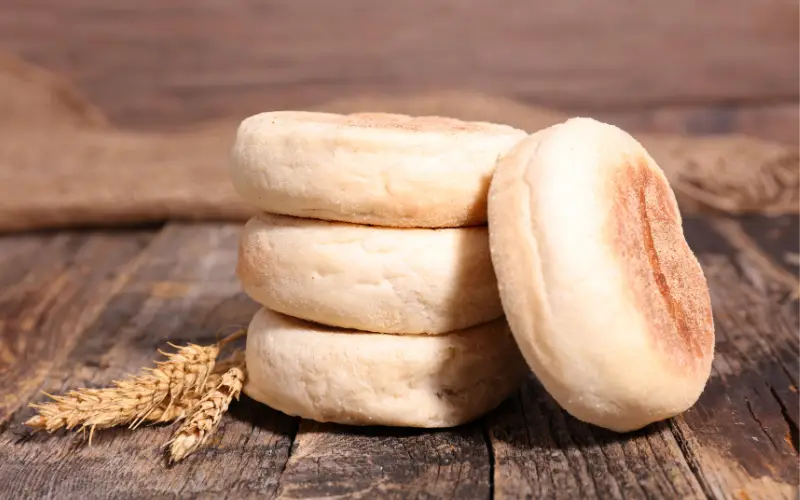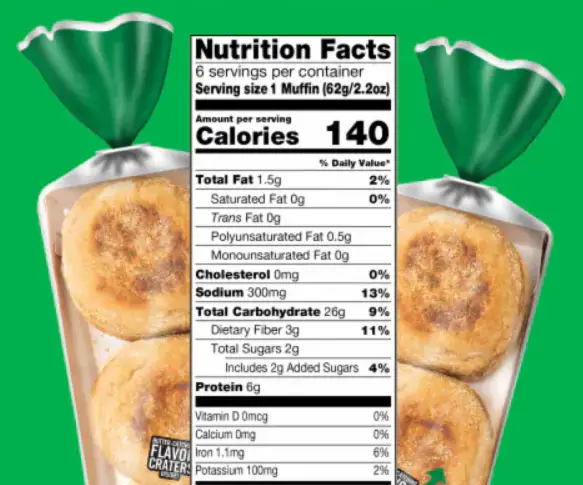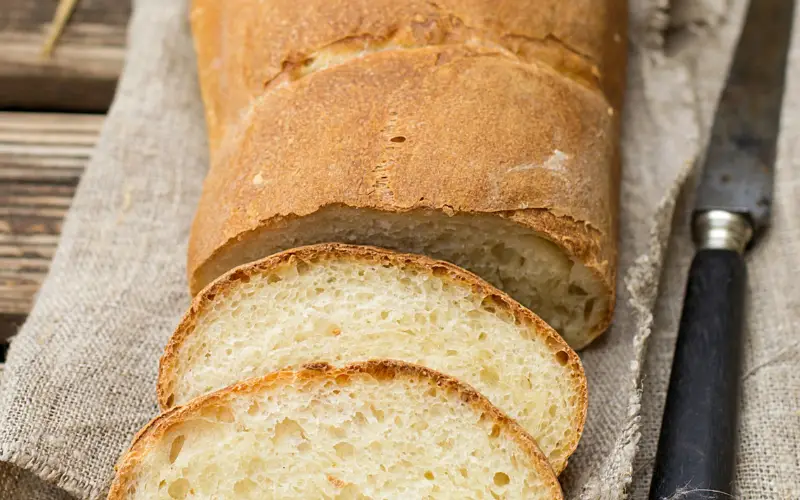Direct Answer: English muffins are slightly lower in calories than bread, at 127 calories per muffin versus 157 calories in two slices of wheat bread. However, both are carbohydrate-rich foods providing efficient energy for your brain, muscles, and other tissues.
When it comes to breakfast or a quick snack, two popular choices are English muffins and slices of bread. Both options can be versatile and delicious, but they also differ in their nutritional content. Understanding the nutritional facts of English muffins and slices of bread can help you make an informed decision about which option best suits your dietary needs and preferences.
What Is English Muffin?

English muffins, typically made from flour, yeast, and sugar, can be a good source of carbohydrates, particularly if made with whole-grain flour or based on wheat or oats. These ingredients deliver complex carbs and fiber to keep you fuller longer, providing energy and nutrients. They’re low in saturated fat too.
English Muffin Nutrition Facts:

- Calories: 132
- Fat: 1g
- Sodium: 246mg
- Carbohydrates: 25g
- Fiber: 2g
- Sugars: 2g
- Protein: 5.1g
What Is Bread Made Of?

Bread is a staple food consumed by people all around the world. It is made from a few basic ingredients, including flour, water, yeast, and salt. Flour, usually wheat flour, is the primary ingredient and provides the structure and texture of the bread. Water is essential to activate the yeast and create the dough’s desired consistency. Yeast is responsible for the fermentation process, converting the sugars in the dough into carbon dioxide, which helps the bread rise and creates air pockets within the structure. Salt is added for flavor and also plays a role in controlling the fermentation process.
Some bread recipes may include additional ingredients such as sugar, oil, milk, or eggs to enhance flavor, texture, or nutritional content. Bread is a versatile food that can be enjoyed in various forms, from crusty baguettes to soft sandwich loaves, offering a satisfying and nourishing addition to meals.
Bread Nutrition Facts
A staple in many diets, a slice of bread packs its own nutritional punch:
- Calories: 82 (per slice)
- Fat: 1.1g
- Sodium: 144mg
- Carbohydrates: 13.8g
- Fiber: 1.9g
- Sugars: 1.4g
- Protein: 4g
- Manganese: 0.7mg
English Muffin Vs Slice Of Bread: Nutritional Facts
Iron And Selenium:
Iron and selenium are essential minerals for our health. Iron is crucial for producing hemoglobin, which carries oxygen in our blood, and selenium aids in metabolism and thyroid function.
English muffins contain about 1.5mg of iron and 13.9 mcg of selenium per 100g. Bread, on the other hand, has around 1.2mg of iron and 11 mcg of selenium per 100g. So, English muffins slightly edge out a slice of bread in these two minerals.
Calcium And Niacin:
Calcium is necessary for bone health and the proper functioning of the heart, muscles, and nerves. Niacin, a form of vitamin B3, helps convert food into energy.
Per 100g, English muffins contain 176mg of calcium and 2.3mg of niacin, while bread contains around 138mg of calcium and 2.8mg of niacin. Here, the English muffin is a better source of calcium, while a slice of bread provides more niacin.
Fat, Carbohydrates, And Protein:
When it comes to macronutrients, there are differences between English muffins and bread slices. Per 100g, English muffins contain about 1.2g of fat, 48g of carbs, and 8.3g of protein. A slice of bread has around 1.1g of fat, 49g of carbs, and 9g of protein. While the differences are minor, bread wins the protein round and comes in a close second in the fat and carbs category.
Dietary Fiber And Sugar:
Both English muffins and slices of bread provide dietary fiber, which aids digestion and helps maintain a feeling of fullness. English muffins contain about 3g of fiber and 2.4g of sugar per 100g, while bread contains 2.4g of fiber and 4.2g of sugar per 100g. Hence, English muffins lead in terms of fiber content and less sugar.
Vitamins:
Both English muffins and slices of bread offer a range of vitamins, with B vitamins being the most prevalent. English muffins provide slightly higher amounts of folate and vitamin B6, while slices of bread may offer more thiamin and riboflavin.
English Muffin Nutrition By Variety
Different types of English muffins bring diverse nutrition to the breakfast table:
- 100% Whole Wheat: 118 calories, 5g protein, 23g carbs, 4g fiber, 5g sugar, 1g fat, 211mg sodium.
- Multigrain: 136 calories, 5g protein, 27g carbs, 2g fiber, 0g sugar, 1g fat, 173mg sodium.
- Oat Bran: 137 calories, 6g protein, 23g carbs, 3g fiber, 4g sugar, 3g fat, 205mg sodium.
- 100% Whole Wheat with Raisins: 123 calories, 5g protein, 25g carbs, 4g fiber, 7g sugar, 1g fat, 193mg sodium.
- Sandwich-Sized: 209 calories, 8g protein, 41g carbs, 3g fiber, 3g sugar, 2g fat, 391mg sodium.
FAQ
Can a type 2 diabetic eat English muffins?
Yes, especially whole grain or oat-based varieties, but portion size and toppings must be carefully considered.
Can English muffins be frozen?

Yes, Just pop them into a resealable plastic bag and into the freezer. Then remove, reheat, and enjoy.
Is an egg on an English muffin healthy?
Yes, eggs on muffins will be healthy and delicious too! Eggs add essential protein for strong muscles and long-lasting energy.
Is an English muffin healthier than a bagel?
Yes, English muffins often contain fewer calories, fats, and carbs and more fiber than bagels. Plus, they are a good source of various nutrients like manganese and riboflavin.
Conclusion
English muffins typically contain fewer calories and carbohydrates than a slice of bread, making them an appealing choice for those managing caloric intake or carbohydrate consumption. On the other hand, bread, especially whole grain varieties, may offer higher fiber content and an array of other nutrients, making it a robust and nutritious option. The choice between an English muffin and a slice of bread should not solely depend on their nutrition facts. Factors such as taste, texture, and how well each complements your preferred fillings or toppings should also be considered.
Keynotes Summary:
- English muffins have slightly fewer calories than two slices of bread.
- Both are good sources of complex carbs and fiber, particularly when made with whole grains.
- Nutrition varies based on the type of English muffin or bread.
- Always consider the nutritional impact of toppings.
- Both can be part of a balanced diet. Choose according to your nutritional needs and tastes.

John Hebdon is a food enthusiast, passionate chef, and author of various articles and blog posts related to food and cooking. With a deep love for all things culinary, John’s blog serves as a platform to share his extensive kitchen experiences with a broader audience.
In addition to his culinary expertise, John has a flair for writing and a natural ability to share his passion for food with others. His articles and blog posts are informative, engaging, and packed with practical tips for readers of all skill levels.
As a food enthusiast and writer, John is always on the lookout for new and exciting culinary experiences. Whether it’s trying out a new restaurant, experimenting with a new recipe, or simply sharing a favorite dish with friends and family, John is always eager to explore and share the world of food with others.







